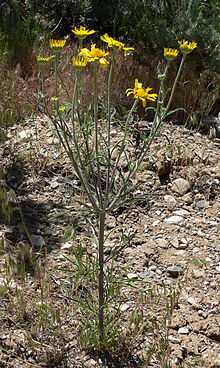Hymenoxys lemmonii
From Wikipedia, the free encyclopedia
| Hymenoxys lemmonii | |
|---|---|
 | |
| Conservation status | |
| Scientific classification | |
| Kingdom: | Plantae |
| (unranked): | Angiosperms |
| (unranked): | Eudicots |
| (unranked): | Asterids |
| Order: | Asterales |
| Family: | Asteraceae |
| Genus: | Hymenoxys |
| Species: | H. lemmonii |
| Binomial name | |
| Hymenoxys lemmonii (E. Greene) Cockerell | |
Hymenoxys lemmonii is a species of flowering plant in the daisy family known by the common names Lemmon's rubberweed, Lemmon's bitterweed, and alkali hymenoxys.[1] It is native to the western United States in and around the Great Basin. This is a biennial or perennial herb with one or more branching stems growing erect to a maximum height near 50 centimeters. It produces straight, dark green leaves up to 9 centimeters long and divided into a number of narrow, pointed lobes. The foliage and stem may be hairless to quite woolly. The daisylike flower head is generally at least 1.5 centimeters wide, with a center of thick golden disc florets and a shaggy fringe of golden ray florets.
References
- ↑ Hymenoxys lemmonii. Germplasm Resources Information Network (GRIN).
External links
| Wikimedia Commons has media related to Hymenoxys lemmonii. |
- Hymenoxys lemmonii. The Jepson eFlora 2013.
- USDA PLANTS
- CalPhotos
This article is issued from Wikipedia. The text is available under the Creative Commons Attribution/Share Alike; additional terms may apply for the media files.
